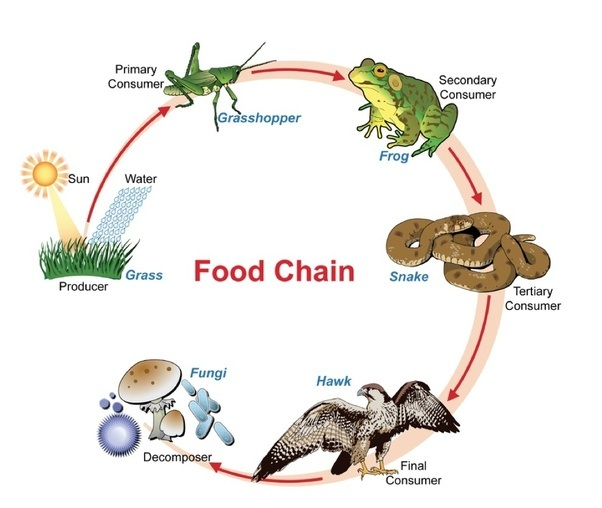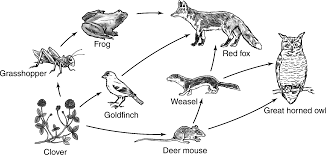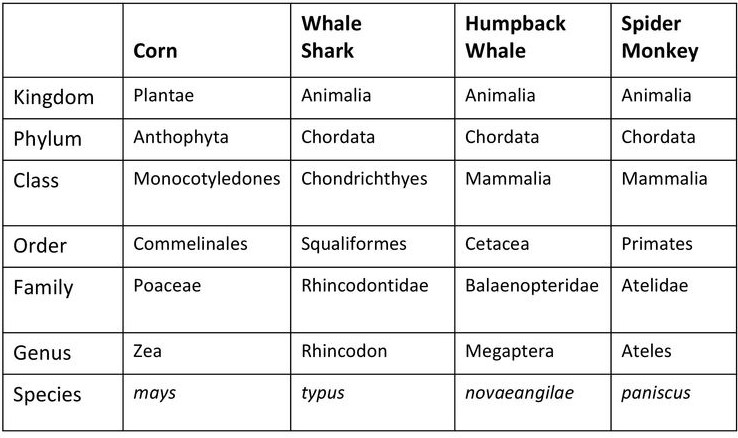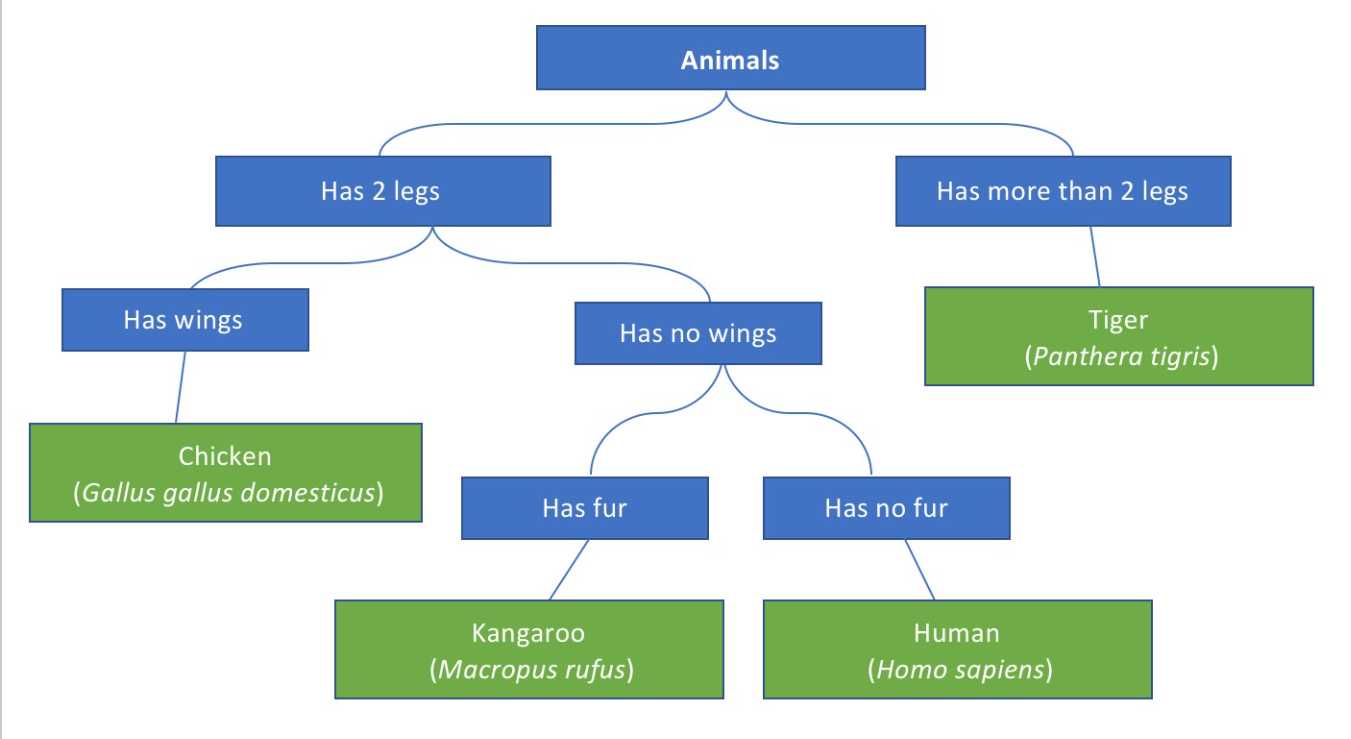The formal two-term naming system created by Carl Linnaeus and used in taxonomy is called ____________________.
Why do scientists use dichotomous keys?
The living and non living things that make up an ecosystem are known as _____________ and ____________ .
Abiotic and biotic factors.
Describe what a native species is.
One that occurs naturally in that area.
The scientific name for a cat is Felis catus. Which Genus does it belong to?
Felis
State 3 of the six kingdoms for life used for classification.
Any three from -
Animalia, Plantae, Monera, Bacteria, Archaebacteria, Fungi
Name the three different types of dichotomous keys
Tabular, Branching and Circular
What do the arrows in a food chain or food web represent?
Transfer of energy/Being eaten by.
Identify three different invasive species in Australia.
Can include any three species such as -
Cane toad, Fox, Cat, Pig, Fire ants, Prickly pear, Rabbit, Camel, etc.
How do you know if an organism is an invertebrate?
The organism won't have a spinal cord.
Identify the seven main levels of taxonomy classification in order, and explain the difference between the first and the last level.

Identify 3 features that would be considered weak when classifying organisms. Why?
Colour, Size, Shape, Behaviour, Environment
These are not the best features as they can change over time or vary between specimens of the same species.
Draw a diagram of a food chain that includes at least 4 organisms, identifying the producer and level of consumer for each.
Example response -

What methods can be used to reduce the impact of invasive species?
Sterilisation, pesticides, containment, culling and removal have all been used previously to remove invasive species.
What characteristics does an organism need to have to be classified as living?
A living organism responds to change in their environment, grow and reproduce, excrete waste and need energy to survive.
Give two other names that can describe an organism that makes their own food. Provide an example and explain how they do this.
Two of any of the below - Plant, Primary Trophic level, Autotroph, Producer.
Example response - Producers or autotrophs are organisms, such as plants and trees, that produce their own food through photosynthesis. This is the process where they use energy from the sun, carbon dioxide and water to make energy and oxygen.
Design a dichotomous key that can classify the following: Turtle, Cow, Rooster and Potato Chips -

Example (tabular): 
Explain what would happen if the frogs were removed from the below food web - 
If the frog was to be removed from the food web, the grasshoppers population would increase as their only current predator gone. The red fox will have less food available and will need to eat more goldfinch and weasels which may lead to a decrease in their population. The deer mouse population may temporarily increase with less predation from weasel, but as the weasel is a food source for owl along with the deer mouse, more likely they will end up being more food for the owl. These disruptions will normally balance again over time as organisms within the web adjust and adapt.
Camels were introduced to Australia in the 1840s. State whether they are invasive or not, and explain why.
Camels are invasive in Australia as they are impacting the native ecosystems, causing disruptions to the food webs and their habitats. Their population grows quickly, they steal the plants that other herbivores would eat and cause soil erosion and property damage. These factors all lead to them being considered invasive not just introduced.
Explain some of the similarities and differences between plant cells and animal cells.
Plant and animals cells both have cell membranes, a nucleus and are both eukaryotic (make up multicellular organisms). However plant cells also contain certain things specific to them, which include a large vacuole, cell wall and chloroplasts (so they can photosynthesise).
Refer to the table below to identify which two organisms are classified as most similar. Justify your answer using all the characteristics you would expect them to share based on this information. 
The Humpback Whale and Spider Monkey are the most similar according to the classification table based on sharing the same Class. They are both part of the Animalia Kingdom (meaning they are animals and multicellular). Both are in the Chordata Phylum (meaning vertebrates - have spinal cord). Being that they are in the Mammalia Class that means that they bear live young and mothers can produce milk. They have no further similarities for the purpose of classification.
What would need to change in the below dichotomous key for a snake to be added?

Example change - 
Predict what would happen if an apex predator was removed from their food chain. Justify your answer.
Responses may vary. Example -
Explain the difference between an introduced species and an invasive species. Provide examples.
An introduced species is a non native species that has ended up in a new environment but it does not disrupt the ecosystem or create negative effects. Example species include earthworms and cactus moths. However the invasive species is one that has been introduced and is having a negative impact on the native species in the area. Some example invasive species include cane toads and rabbits.
Justify how biodiversity in an ecosystem can be reduced by the impacts of invasive species.
Biodiversity relates to the different types of life in any given ecosystem and is important to maintain balance. Invasive species have devastating impacts on native ecosystems, causing decline or even extinctions of native species, and cause food webs to become unbalanced. Invasive species are known to reproduce rapidly, out-compete native species for food, water and space, and are one of the main causes of biodiversity loss. Often introduced species have no natural predators in their new habitats and this leads to dominance and reduction in the diversity within that system.